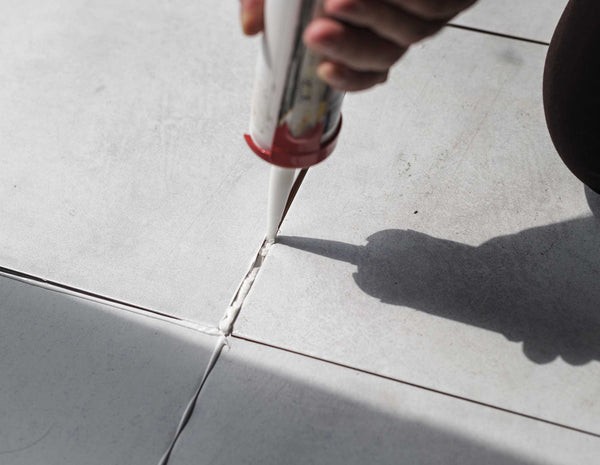Have you ever wondered what that substance is between your tiles? It’s called grout, and it’s a vital component of tile installations and other construction projects. This guide will delve into the world of grout, exploring its definition, purpose, types, and color options.
What Exactly Is Grout?
According to the Tile Council of North America, grout is a mixture of cement, aggregate, and other ingredients (like sand or water) that produces a water-resistant, dense, and uniformly-colored material commonly used for filling gaps or reinforcing existing structures.
In simpler terms, grout is a material used to fill and seal gaps, cracks, or voids in various materials. It’s not just for aesthetics; grout plays a crucial role in the structural integrity and longevity of tiled surfaces.
There are two main categories of grout: cementitious grout and chemical grout. Each has its own subcategories with specific properties, which we’ll explore in more detail below.
What Does Grout Do? Unveiling its Purpose
Grout’s primary purpose is to fill the spaces between tiles, creating a seamless and water-resistant surface. This prevents tiles from shifting, cracking, or becoming damaged over time. Grout also prevents water from seeping beneath the tiles, which can lead to mold growth and structural damage.
Beyond tile installations, grout is used in pressure grouting, a technique that injects grout into soil or structural voids to strengthen and stabilize foundations. It’s also used for embedding rebar in masonry walls and connecting pre-cast concrete sections.
Understanding Grout Terminology
To better navigate the world of grout, here are some essential terms:
- Grout Joints: The space between the tiles that the grout fills.
- Grout Float: A handheld tool, similar to a trowel, used to press grout into the joints between tiles.
- Grouting Sponge: A high-water retention sponge used to remove excess grout from the tile surfaces after application.
Exploring the Common Types of Grout
Choosing the right type of grout is critical for the success of any tiling project. Each type has unique properties that make it suitable for specific applications.
Cementitious Grout: The Traditional Choice
Cementitious grout is a widely used option, made from a mixture of cement, sand, and water. The cement acts as a binding agent, and the amount of water added determines the grout’s consistency and flow. Cementitious grouts are versatile and can be used for various applications. There are two main subtypes:
- Sanded Grout: Contains silica sand, which adds strength and reduces shrinkage. It’s ideal for larger grout joints (1/8 inch to 3/8 inch or wider), making it suitable for flooring applications and areas with high foot traffic. Sanded grout is generally more affordable but can be abrasive and porous, requiring sealing to prevent staining. A variation is Quarry-Type Grout, which utilizes a coarser sand grain for joints 3/8 inch to ½ inch wide, often used with Saltillo tiles.
- Unsanded Grout: Made without sand, making it suitable for narrow grout joints (less than 1/8 inch wide). It’s stickier than sanded grout, making it easier to work with on vertical surfaces like shower walls. Unsanded grout is a good choice for delicate surfaces like glass, metal, or polished stone, as it won’t scratch them. Sealing is recommended, but not always required.
- Polymer-Modified Cement Grout: Enhanced with polymers like latex, these grouts offer improved strength, water resistance, and color consistency compared to traditional cementitious grouts. They are suitable for high-traffic areas, commercial spaces, and kitchen backsplashes.
Epoxy Grout: The High-Performance Option
Epoxy grout is a chemical grout made from epoxy resins, aggregates, and hardeners. It’s known for its exceptional durability, chemical resistance, and stain resistance. Unlike cementitious grouts, epoxy grout is non-porous and doesn’t require sealing.
Epoxy grout is ideal for areas exposed to moisture, such as showers and floors, as well as high-traffic areas and commercial spaces. It also offers excellent color consistency and resists mold and mildew growth.
However, epoxy grout is more expensive and can be more difficult to install than cementitious grout. It also has a plastic-like appearance that may not appeal to everyone, and it takes longer to cure.
Is Epoxy Grout Superior to Regular Grout?
While epoxy grout offers numerous advantages, it’s not always the best choice. The higher cost, more complex installation, and longer curing time can be drawbacks for some projects. Cementitious grout remains a viable option for many applications, particularly where budget and ease of installation are priorities.
-
Epoxy Emulsion Grout: A hybrid option that combines cement and epoxy resins. While not as stain-proof as 100% epoxy grout, it offers greater strength and chemical resistance than polymer-modified cement grouts.
-
Furan Grout: Another chemical grout option known for its exceptional chemical and heat resistance. Furan grout is typically used in industrial settings and with brick pavers and quarry tiles. However, it requires specialized installation techniques and cannot be washed with water.
Choosing the Right Grout Color
Grout color significantly impacts the overall aesthetic of a tile installation. It can either blend seamlessly with the tiles or create a striking contrast.
Thankfully, a vast array of grout colors is available, and some manufacturers even offer custom coloring services.
Should You Match Grout Color to Tile?
The decision to match grout color to tile is a matter of personal preference. A matching grout color creates a cohesive and uniform look, while a contrasting color adds visual interest and highlights the tile pattern.
Explore Grout Possibilities by Browsing our Gallery
Should You Use Darker Grout With Lighter Tile?
Using dark grout with light tile creates a dramatic contrast, emphasizing the tile’s shape and pattern. Dark grout can also hide dirt and stains more effectively, making it a practical choice for high-traffic areas.
However, be aware of grout haze, which can occur when excess residue dries on the tile surface. Dark grout can amplify the appearance of grout haze, so take extra caution during installation and seal your tiles beforehand to prevent absorption.
Why is Grout Necessary Between Tiles?
Grout is not just about aesthetics; it’s a crucial structural component of tile installations. It locks the tiles in place, preventing them from shifting or cracking over time. Grout also protects the edges of the tiles from chipping and prevents water from seeping beneath the surface.
What Grout is Recommended for LIVDEN Tiles?
For sustainable and high-design LIVDEN tiles, unsanded grout is generally recommended.
Grout: The Unsung Hero of Tile Installations
From its definition and purpose to its various types and color options, we’ve covered the essentials of grout. Understanding the role of grout is crucial for ensuring the success and longevity of any tiling project.
If you have further questions about pairing modern tiles with different grouts, reach out for expert guidance. And if you need inspiration for your next project, explore our collection of decorative tiles made from recycled materials.

